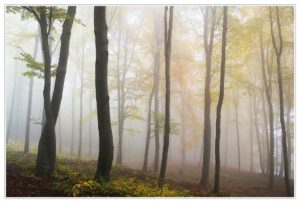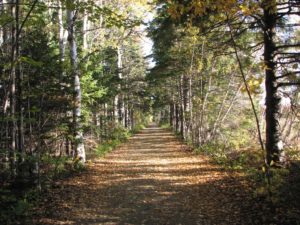08 Aug Blog: Forests, Ecosystem Services, and Climate Change
Forests, Ecosystem Services and Climate Change
Kate Slorach, Nature NB
August 2018
Why are forests important?
Pristine streams weave through the trees and in the distance woodpeckers hammer into old trunks in search of food. Strolling under a cool, shaded tree canopy it is easy to see the many ways forests support humans and wildlife. Forests are special places that have been used for centuries as a place to reconnect, rejuvenate, and reflect. Even in our cities, urban forests and trees provide us with a multitude of natural services, at no cost, that benefit us every day. For instance, trees shade our homes, reduce water runoff, and can protect our properties against erosion. Forests provide many other benefits including:
- Carbon storage
- Fresh, clean air
- Water storage
- Water filtering
- Flood protection: soaks in water through roots; acts as barrier
- Reduce erosion: roots hold onto soil
- Provides habitat for wildlife
- Provides food and medicine: berries, maples syrup, mushrooms, hunting game, etc.
- Acts as windbreaks to protect crops
- Culturally or spiritually important areas
- Recreation and physical health (hiking, camping, hunting, etc.)
- Improvements to mental health
Unfortunately, we tend to take forests for granted and do not manage forests to ensure these services are maximized. We often damage forests through clearcutting, development and pollution. While we benefit from the conversion of forest land and its products, such as timber and agricultural land, we lose a great deal of services that benefit our health, safety and well-being when forests are removed. As a result, we have a need to strike a balance between resource extraction and the preservation of these natural benefits.
One way to preserve these natural benefits is to protect key forests and natural areas. When compared to other provinces, New Brunswick has the second lowest percentage of protected natural areas. The average of all provinces and territories is about 10%. New Brunswick reaches only 4.6%. Therefore, there is an opportunity for New Brunswick to protect these forest services, while increasing the number of protected areas in the region.

Forests and Climate Change
One of the more worrying losses that come with forest destruction is the loss of protection from storms and floods. This is becoming a more prominent issue as a result of climate change and its expected effects on the region (e.g. increased severe weather and flooding events, higher frequency of intense rainfall). Our forests help protect us from storms and floods by absorbing and slowing down rain water as it hits the surface of the land. Forests can also mitigate the effects of climate change by storing carbon dioxide (CO2) – a primary greenhouse gas – that is a known contributor to climate change. Global forest removal is estimated to contribute 18-25% of global greenhouse gas emissions every year, meaning protecting and conserving our forests is critically important to help stabilize emissions. Deforestation and Flooding Deforestation can happen through forests fires, disease, and insect infestation, or by harvesting trees for timber. Research has shown that excessive forest harvesting has influenced the frequency and intensity of floods in some areas in Canada. Some scientific studies have related several factors to reduced forest cover and increased flooding.
These factors include:
- A loss in forest canopy translates into a reduction in interception, meaning more snow and rain collects on the forest floor, increasing risk of flooding.
- With little to no vegetation to absorb this excess water, there is an increased chance of run-off during heavy rain events.
- Solar radiation (sunlight) can reach the entire ground surface as there is no shading from trees. This leads to higher surface temperatures and snow melting more quickly than usual. Rapid snow melt causes peak water flows that may heighten water levels and cause flooding.
- Saplings and shrubs that breach through the snow can contribute to higher snow melt as the solar radiation reflects off the vegetation and warms the surrounding snow.
- Heavy forestry machinery compact the soil, causing it to lose its sponge-like ability to absorb and hold water. Water runoff is therefore increased.
While the issue of flooding and forests is complex, it is clear that our forests can greatly contribute to the resilience, health, and wellness of our communities. These natural services will become increasingly important as a way to buffer ourselves from a new era of uncertainty and change.

References
Bradshaw, C. J., Sodhi, N. S., Peh, K. S. & Brook, B. W. (2007). Global evidence that deforestation amplifies flood risk and severity in the developing world. Global Change Biology, 13: 2379-2395. doi:10.1111/j.1365-2486.2007.01446.x
Climate Change Canada. (2018, March 07). Canada’s protected areas. Retrieved from https://www.canada.ca/en/environment-climate-change/services/environmental-indicators/protected-areas.html
Green, K., & Alila, Y. (2012, October 03). Deforestation in snowy regions causes more floods. Retrieved from http://www.forestry.ubc.ca/2012/10/deforestation-in-snowy-regions-causes-more-floods/
Green, K. C., & Alila, Y. (2012). A paradigm shift in understanding and quantifying the effects of forest harvesting on floods in snow environments. Water Resources Research,48(10). doi:10.1029/2012wr012449. Retrieved from: https://agupubs.onlinelibrary.wiley.com/doi/abs/10.1029/2012WR012449
Munang, R., Thiaw, I., Alverson, K., Liu, J., & Han, Z. (2013). The role of ecosystem services in climate change adaptation and disaster risk reduction. Current Opinion in Environmental Sustainability,5(1), 47-52. doi:https://doi.org/10.1016/j.cosust.2013.02.002
Winkler, R. D., Moore, R. D., Redding, T. E., Spittlehouse, D. L., Smerdon, B. D., & Carlyle-Moses, D. E. (2010). The Effects of Forest Disturbance on Hydrologic Processes and Watershed Response. In Compendium of Forest Hydrology and Geomorphology in British Columbia (pp. 179-212). B.C. Ministry of Forests and Range. Retrieved from: http://citeseerx.ist.psu.edu/viewdoc/download?doi=10.1.1.398.2329&rep=rep1&type=pdf



Johanne
Posted at 12:56h, 27 AugustGood blog